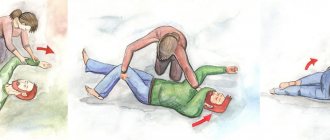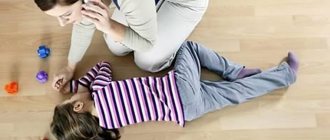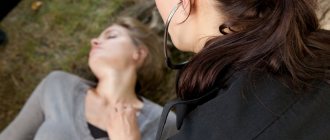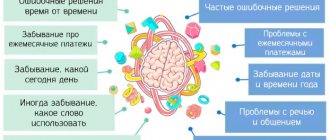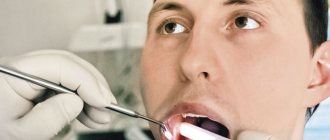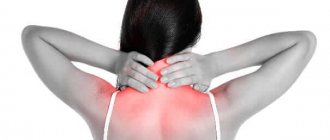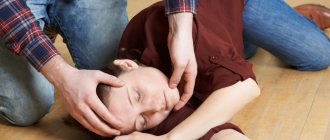From this article you will learn:
- How does dizziness manifest in an elderly person?
- What are the causes of dizziness in older people?
- What drugs can cause dizziness in an elderly person?
- How is dizziness treated in an elderly person?
- What to take for dizziness in an elderly person
Dizziness is a person’s feeling of disorientation in space. In medicine, the term “vertigo syndrome” is often used. Of course, dizziness occurs due to many reasons. Fatigue, hunger, tiredness and much more. If all these signs are absent, and there are no manifestations of external influences on the body, then dizziness may be a sign of serious illness.
Dizziness in older people is quite common. It is necessary to determine the cause of its occurrence and, if possible, eliminate it. Treatment for dizziness can take different approaches. Vertigo syndrome is treated with medications, traditional medicine recipes, and physiotherapy.
How does dizziness manifest in an elderly person?
When dizziness occurs, a person has the feeling that he himself is spinning in space, or space is spinning around him. The feelings that people with vertigo syndrome experience can range from drunkenness to nausea. At times, loss of consciousness occurs and falls are likely. There are other unpleasant moments.
Dizziness in older people is often both a sign of exposure to external factors and also means the presence of diseases inside the body. It is unlikely that there are people over the age of sixty who do not at least sometimes feel dizzy. If this happens periodically, it interferes with normal life activities. This condition simply needs to be corrected. For successful treatment of dizziness in older people, it is important to identify the causes of its development and origin.
- Recommended articles to read:
- Social services for older people
- Diseases of old age
- Valuable tips on how to choose a boarding house
Reasons for the occurrence of the violation
If a person suddenly begins to feel dizzy, then he needs to change his position to horizontal as soon as possible. Most often, after this, unpleasant symptoms quickly disappear, fear goes away, and consciousness becomes clear.
Severe dizziness in a lying position may indicate particularly dangerous disorders in the patient’s body. Factors in the development of this condition may be:
- Arterial hypertension. The disease is accompanied by an increase in blood pressure, especially in the morning, when a person experiences a surge in hormonal activity. Indicators exceeding 170/100 millimeters of mercury cause ischemia of the brain centers and heart.
- Osteocondritis of the spine. With this disease, the nutrition of the intervertebral discs deteriorates, which results in a change in their elasticity.
- Mier's disease occurs due to ischemia of the structure of the inner ear, vestibular, and also the auditory nerve. In this case, the patient complains of gagging, dizziness and lack of coordination in space.
- Internal otitis (labyrinthitis), ear injuries. In this case, there is a disruption in the conduction of impulses to the vestibular centers. Even when the patient is in a horizontal position, there is a feeling of pain in the ears, nausea and dizziness before the eyes.
- Brain tumors, classified as malignant and benign, provoke tissue compression. The patient experiences severe pain in the head, vomiting, and decreased visual acuity. Dizziness usually occurs at night. You feel dizzy when lying on your back, and there is a feeling of a change in body position.
- The use of sedatives and sleeping pills often negatively affects the functioning of the brain. This is especially pronounced in women, who are characterized by a surge in hormone levels. After waking up, a person has a feeling of nausea, dizziness begins and the focus of the gaze on a certain object is impaired.
- In first-degree diabetes mellitus, the patient's blood vessels supplying blood to the brain become severely swollen. A sharp increase in blood glucose can cause lethargy, nervousness, and in some cases dizziness.
- If a traumatic brain injury has recently been sustained, the patient may complain of headaches, decreased vision and temporary seizures. If the damage affects the vestibular system or leads to increased intracranial pressure, the person may experience nausea, dizziness, and vomiting, after which the condition does not improve.
Doctors recommend that if you feel dizzy in the morning, do not get out of bed abruptly. During an attack, you need to calm down. To do this, close your eyes and begin to breathe deeply, pressing your thumbs on your eyeballs for 10-15 seconds.
The head may begin to spin due to other diseases, so it is very important to consult your doctor in advance to diagnose and find out the cause of the ailment. Only through special research and testing can you determine exactly what exactly provokes dizziness in a horizontal position.
To diagnose a patient, doctors use various blood tests, vascular Dopplerography, MRI, X-rays and some other studies.
To make a correct diagnosis, a specialist must find out exactly how the attack proceeds, whether the person’s condition changes during this, and whether there are additional symptoms (weakness, painful feelings, hearing loss, tinnitus and other problems).
That is why it is very important to monitor what feelings the patient experiences when dizzy. This will help to correctly and quickly determine the cause of the disease and prescribe adequate treatment.
What are the causes of dizziness in older people?
Dizziness in older people is a fairly common phenomenon that is directly related to age, vestibular disorders, neurological changes, vascular problems, and destruction of nerve cells. The main point here can be considered poor blood supply, ischemia and atherosclerosis.
Not only disturbances in the functioning of the vestibular apparatus lead to dizziness. Neurological diseases also lead to it, for example Parkinson's disease and other diseases of a neurotic nature. The influence of somatic ailments such as diabetes mellitus and cardiac arrhythmia is also possible.
Often, dizziness in older people is provoked by changes of an emotional and psychological nature. Limitations in their physical condition and transition to a different social status cause psychological maladaptation in them. If an elderly person suffers from phobias and other disorders of consciousness, this has an even more negative impact on the situation.
Most people whose vestibular apparatus does not work well feel the circular movement of objects in space. If the problem is serious, then there may be a disturbance in the perception of the outlines of objects that surround the person. This often happens with hypertensive patients. Along with these symptoms, the following may occur:
- spots in the eyes, feeling of blindness
- heaviness in the head
- faintness
- feeling of cottony limbs and apathy towards everything that is happening
If the manifestation of these signs is one-time in nature, then this can only indicate fatigue. Once you rest, the discomfort will disappear on its own.
But if these signs appear during menopause or after a stroke, then you should pay more attention to them. They can negatively affect human life. He begins to experience fear when an attack occurs, loses consciousness, and may fall and get injured. All this is unsafe for an elderly person.
If you have at least one of the above symptoms, go to the doctor. Don't waste time. Visit a therapist, neurologist and endocrinologist to determine the true cause of the disorders. This takes time because it is difficult to make a diagnosis right away. A thorough study of the central nervous system, collection of tests and the results of numerous examinations are required.
Additional signs of dizziness
If dizziness is episodic, then this should not be a cause for concern. However, in case of periodic attacks or the manifestation of certain pathological conditions, it is recommended to undergo a medical examination and, if necessary, treatment.
Signs indicating urgent treatment for vertigo:
- Sudden weakness.
- Lack of appetite for more than a day.
- Blurry image before the eyes.
- Noise and buzzing in the ears.
- Low (below 55 beats/min.) or high (over 100 beats/min.) pulse.
- Coldness in lower and upper extremities.
- Unclear speech.
- Blood pressure surges.
The appearance of at least one of these signs indicates the presence of a serious problem and is a reason to see a competent specialist. After the examination, the doctor will prescribe a course of treatment and other measures to promote a speedy recovery.
What medications can cause dizziness in an older person?
The list of medications that have dizziness among their side effects can be endless. For example:
- analgesics (painkillers)
- cardiac
- normalizing blood pressure
- beta blockers
- diuretics
- antibiotics
- nonsteroidal anti-inflammatory drugs
- antidepressants, tranquilizers and sleeping pills
- anticonvulsants
Read material on the topic: Caring for disabled pensioners
Benign vestibular vertigo
Benign vestibular vertigo is most often considered a pathology of the inner ear; dizziness often occurs when turning the head to the side. The disease may manifest as sudden severe dizziness, nausea and vomiting. Paroxysmal benign positional vertigo develops as a result of the deposition of calcium salts in the ampulla of the semicircular canal. Peripheral vestibular vertigo occurs when the peripheral part of the vestibular apparatus is damaged. Systemic vestibular vertigo is manifested by symptoms of swaying one's own body, rotating objects, bending or falling, accompanied by impaired hearing, balance, nausea and vomiting. Caused by damage to the central or peripheral part of the vestibular system.
How to provide first aid if an elderly person has severe dizziness
If an elderly person complains of dizziness, it is necessary to put him in bed and open the windows to ensure free access of oxygen. Take 8-10 drops of atropine (0.1%) and give it to the person to drink. To normalize the functioning of the nervous system in this situation, it is necessary to start taking tranquilizers.
The most important thing in treating the problem of dizziness is a correct diagnosis. Above, we gave recommendations on which specialists should be diagnosed.
Often the cause of dizziness in older people is changes in the functioning of the brain. If there are such suspicions, then additional research is necessary:
- Ultrasound of the brain;
- Electroencephalography;
- MRI of the brain.
Carrying out therapeutic exercises
To protect yourself from dizziness and increase the body's resistance to disease, you should perform some sets of exercises:
- Close your eyes and try to draw a circle with them. Sessions last for several minutes before going to bed and after waking up. The exercise is performed while lying on your back.
- Smooth movements of the head from side to side for several minutes help strengthen the vestibular system and prevent feelings of nausea.
- Pressing your fingers on the eyes helps eliminate vomiting and vertigo.
Dizziness while lying down can occur at different ages. Since this ailment can be provoked by various reasons, the patient needs to seek help from an experienced specialist as quickly as possible, who will carry out the necessary diagnostics and prescribe treatment.
ONLINE REGISTRATION at the DIANA clinic
You can sign up by calling the toll-free phone number 8-800-707-15-60 or filling out the contact form. In this case, we will contact you ourselves.
If you find an error, please select a piece of text and press Ctrl+Enter
Dizziness in an elderly person: treatment
Treatment of dizziness in older people is, first of all, determining the cause and choosing the right set of therapy. If the cause of dizziness lies in the vascular system of the brain, then treatment with drugs for atherosclerosis and ischemia is usually carried out. If the cause is a violation of the neural functions of the brain, then medications are prescribed that restore neural connections of the central nervous system.
Dizziness with high blood pressure is treated with a special group of medications, as well as traditional medicine recipes.
If you have dizziness, you should never self-medicate. Especially in old age. Strict compliance with the doctor’s instructions is the key to a successful solution to the problem.
How to treat vestibular vertigo
Dizziness is a common complaint among patients about feeling unwell. Women and the elderly most often suffer from dizziness. Depending on the cause of dizziness, the doctor prescribes treatment. Treating dizziness is a difficult task for a doctor. He refers the patient for examination to determine whether dizziness is caused by diseases. The patient is prescribed symptomatic treatment, which helps to remove symptoms - nausea, vomiting, and stop attacks of dizziness. Vestibular suppressors are used to stop attacks. To prevent attacks from developing, your doctor may prescribe anticholinergic drugs. Such drugs are prescribed with caution to elderly people due to side effects - hallucinations, amnesia, they can cause urinary retention and psychosis in an elderly patient. Some types of antihistamines and benzodiazepines are also prescribed to enhance the inhibitory response of GABA to the patient’s vestibular system.
What medications are prescribed for dizziness in older people?
What medications for dizziness in older people are recommended by medicine?
The problem of dizziness in old age is very common. There is a class of drugs that reduce the number of dizziness attacks and have a beneficial effect on the brain. They are called nootropics. These include medications that speed up neural connections in the brain. They are prescribed for memory problems, mental impairment, senile sclerosis, and dementia. Nootropics are often used for problems with blood circulation, chronic fatigue, insomnia, and depression.
Nootropics are not only safe to use, but also have extensive effects. They are prescribed even to children and completely healthy people whose work requires constant attention and concentration. Drugs in this group act differently, so it is better to consult a doctor rather than self-medicate. Here is a list of the main nootropic drugs:
- Glycine;
- Cinnarizine;
- Phenotropil;
- Piracetam;
- Bilobil;
Any representative of the group of nootropics is aimed at improving blood circulation in the brain, eliminating hypoxia, accelerating neural connections in the central nervous system, and strengthening the walls of brain vessels. Some have a sedative effect. These drugs have a good effect on cell metabolism and increase the movement of energy in it. As a result, you can observe an improvement in memory, an increase in the ability to perceive information and an easier learning process. Efficiency and mood increase, sleep normalizes. As a result, the dizziness goes away.
Let's look at some drugs from the group of nootropics in a little more detail:
- Piracetam . The most popular of nootropics. It may disturb sleep, so the drug is taken in the first half of the day.
- Vinpocetine . It has been used for a long time. Does not cause drowsiness. There are no side effects. Contraindicated for pregnant women.
- Cinnarizine . It is prescribed not only for nootropic therapy. Has antiallergic effect. Side effects: drowsiness, dry mouth, gastrointestinal disturbances.
- Glycine . Has no side effects. Very popular with students during sessions. It is based on gamma-aminobutyric acid - an essential element for metabolic processes in the brain, accelerating its work.
- Phenibut . It is also based on gamma-aminobutyric acid. As a side effect, drowsiness is possible after the first doses.
There are also nootropic drugs of plant origin . Here are a few of them:
- Vinpocetine . Created on the basis of Vinca minor. Normalizes brain function by increasing blood supply to ischemic areas by relaxing the walls of blood vessels. May lower blood pressure.
- Bilobil . Created based on the ginkgo biloba plant. Saturates the brain with oxygen, delivers glucose, and increases the resistance of blood vessels to oxygen deficiency. Normalizes memory, helps concentration and improves learning ability. Neutralizes numbness of the limbs.
Any medication for dizziness must be taken for at least three months. The effect of treatment is noticeable only a month after the start of treatment. The frequency of taking the drug depends on its dosage, usually from one to three times a day.
Read material on the topic: Vitamins for older people
Dizziness is one of the most common reasons why older patients visit a doctor. The causes of dizziness at this age differ little from those in other age groups. Among the most common diseases of the peripheral vestibular system accompanied by vertigo are benign paroxysmal positional vertigo (BPPV), Meniere's disease, vestibular neuronitis, and among the central vestibulopathies are migraine-associated vertigo, stroke and transient ischemic attacks (TIA) [1-3]. Stroke is a relatively rare cause of isolated vestibular vertigo, but nevertheless it requires timely diagnosis and urgent treatment.
Age-related changes in the vestibular system, as well as concomitant neurological or somatic diseases, can determine certain features of the course of diseases accompanied by dizziness. Thus, the clinical features of BPPV in the elderly can be considered the development in some cases of instability instead of typical attacks of positional vertigo, a tendency to relapse, and difficulties in carrying out therapeutic positional maneuvers. Meniere's disease in old age is characterized by more pronounced hearing impairment and instability in the interictal period, as well as episodes of sudden falls (Tumarkin's otolith crises). The course of vestibular neuronitis in elderly patients may be longer due to the slow formation of vestibular compensation .
The results of epidemiological studies show that the prevalence of dizziness in old age is 20-30% [4-6]. Such a high prevalence is probably due not only to an increase in the true incidence of some vestibular diseases in old age, but also to the tendency of patients to call a variety of sensations dizziness, including those related not so much to the feeling of imaginary rotation or movements of surrounding objects (i.e. true dizziness), as well as instability. The high incidence of instability in old age can be caused by a variety of diseases - from polyneuropathy and extrapyramidal diseases to orthostatic hypotension and multisensory impairment. Attempts to establish the prevalence of true (or vestibular) vertigo in old age have always been somewhat limited by terminological difficulties and the lack of clear criteria for acute vestibular syndrome. However, a recent study from Germany [7] found that in patients over 70 years of age, the prevalence of vestibular vertigo was 14%.
Some of the diseases under consideration may have certain characteristics that affect the course and approaches to their treatment in old age. This review is devoted to these features. We presented them with data concerning the age-related characteristics of the vestibular system itself.
Age-related changes in the vestibular system
It is known that the vestibular reflex, one of the main reflexes through which the function of the vestibular system is realized, changes significantly with age. The caloric test and rotation test make it possible to assess the state of the vestibulo-ocular reflex and identify its disorders in elderly patients [8]. Moreover, such disorders tend to progress [9, 10]. These data were confirmed by studies using vestibular evoked myogenic potentials. In contrast to the caloric test and rotation test, which assess the function of the horizontal semicircular canals of the inner ear and the superior branch of the vestibular nerve, vestibular evoked myogenic potentials make it possible to determine the safety of the otolithic organ (elliptical and spherical sac), as well as the inferior branch of the vestibular nerve [11, 12]. Studies using vestibular evoked myogenic potentials indicate age-related changes in the functioning of the otolith organ [13-15].
Age-related changes in the peripheral vestibular system include progressive degeneration of the sensory epithelium and primarily type 1 hair cells and efferent nerve fibers [16, 17]. Thus, in one of the recent studies [18], a reduction in hair cells in the ampullary receptor of the semicircular canals was revealed in people over 80 years of age by 12%, and in people over 90 years old by 25% (compared to people aged 42-67 years).
Significant changes also occur in the vascular system of the inner ear: the walls of arterioles thicken due to collagen deposition, and blood flow decreases [19].
The vestibular nerve is also subject to age-related changes. Thus, according to M. Fujii et al. [20], with aging, the axons of the vestibulocochlear nerve gradually become thinner, and amyloid bodies are deposited in the nerve itself. This reduces the conductive capacity of the vestibular nerve. However, the total number of vestibular nerve fibers does not decrease with age.
Age-related changes also affect the central sections of the vestibular analyzer. First of all, they affect the state of the largest of the vestibular nuclei - the medial one. The latter plays a crucial role in ensuring the vestibulo-ocular reflex and in vestibular compensation. According to J. Alvarez et al. [21], by the age of 89, the number of neurons in this nucleus decreases by 62%. Such changes may be the cause of insufficient vestibular compensation in unilateral peripheral vestibulopathies in the elderly.
It can be assumed that vestibular disorders in old age are caused by both genetic factors and external causes [22]. It has been shown, in particular, that strong noise, triggering oxidative stress mechanisms, can cause damage to cochlear receptors [23]. Perhaps similar mechanisms can cause damage to the structures of the peripheral vestibular analyzer.
Clinical features of vestibular diseases in old age
As mentioned above, true (vestibular) vertigo, regardless of age, is most often caused by three main diseases - BPPV, Meniere's disease and vestibular neuronitis.
BPPV is a disease associated with the formation of otolith deposits freely moving in the membranous labyrinth of the inner ear and their penetration into one or more semicircular canals. As a result, every change in the position of the head in the plane of the affected semicircular canal leads to displacement of the otolith deposits and irritation of the ampullary receptor, in response to which an attack of dizziness occurs. BPPV occurs at any age, from childhood to old age, but the peak incidence occurs at the age of 50–70 years [25]. The reason for the highest prevalence of BPPV at this age is not entirely clear. It is believed that the appearance of freely moving otolithic deposits in the inner ear may be due to degeneration of the otolithic membrane of the vestibule of the labyrinth. Perhaps age-related factors, calcium metabolism disorders, and hormonal disorders play a certain role in the degeneration of the otolith membrane [26, 27]. As these factors become more important with age, the prevalence of BPPV also increases.
The clinical features of BPPV in old age come down to several circumstances. Our observations [7] show that in some cases, in elderly patients, BPPV manifests itself not so much as classic attacks of positional vertigo, but rather with a feeling of instability. Positional tests reveal the nystagmus characteristic of BPPV, often accompanied by nonspecific “motion sickness” sensations rather than true dizziness. Carrying out positional maneuvers in such cases eliminated positional nystagmus, and with it instability.
Our observations are confirmed by the results of another recent study [28], according to which the prevalence of BPPV in the elderly is greatly underestimated: conducting position tests in elderly patients who consulted a doctor about dizziness or instability, it was possible to identify positional apogeotropic nystagmus, characteristic of canalolithiasis of the horizontal semicircular canal, in 50% of those examined. At the same time, exercises aimed at treating BPPV led to the gradual disappearance of positional nystagmus and improvement in the condition of patients.
The cause of the uncharacteristic presentation of BPPV in some elderly patients is unclear. One explanation may be age-related degeneration of the sensory epithelium and efferent nerve fibers of the vestibular-cochlear nerve with a subsequent decrease in the sensitivity of the receptors of the peripheral vestibular analyzer. As a result of irritation of the ampullary receptor, canalolithiasis in elderly patients does not necessarily lead to rotational vertigo, but may manifest as more or less significant instability.
At the same time, according to our observations, age factors do not affect the prevalence of atypical forms of otolithiasis. Regardless of age, canalolithiasis of the posterior semicircular canal accounted for 83 to 88% of cases of otolithiasis in patients who consulted a neurologist on an outpatient basis for dizziness. The remaining 12-17% of BPPV cases were caused by “atypical” forms: canalolithiasis of the horizontal or anterior semicircular canals or simultaneous damage to several canals [29].
Data on the comparative effectiveness of therapeutic positional maneuvers in patients of different ages are contradictory. According to some studies, in elderly patients it is no different from younger patients [30]. However, other data suggest that treatment is less effective in the elderly [31], which may be partly due to technical difficulties due to concomitant diseases that are more common in old age (cervical spondylosis deformans, obesity, extrapyramidal disorders leading to limited mobility, and etc.).
Results from studies assessing the effect of age on the recurrence rate of BPPV are also inconsistent. While some authors [31] note a greater tendency of BPPV in old age to recur, others [30], on the contrary, do not see significant differences in the prognosis of the disease in older and younger patients. The reasons for such conflicting data on the effectiveness of treatment and prognosis of BPPV probably lie in the lack of universal approaches to the treatment of this disease. The technique of performing therapeutic positional maneuvers is only partially standardized, and the differences in the methods of carrying out therapeutic procedures among different researchers are apparently significant.
Meniere's disease is the second most common cause of dizziness in older patients. The disease is manifested by attacks of vestibular dizziness, noise in the ear and gradual (fluctuating in the initial stages) hearing loss. It is generally accepted [32] that Meniere's disease affects mainly middle-aged people (30-50 years). Meanwhile, a recent study [33] showed that 15% of patients suffering from Meniere's disease are over 65 years of age. Moreover, if in 40% of the patients participating in this study, the disease was diagnosed before the age of 65, then in the rest, Meniere’s disease debuted after 65 years. However, elderly patients with Meniere's disease in most cases suffer from this disease for many years, which leaves its mark on its clinical manifestations.
The clinical features of Meniere's disease in elderly patients can probably be considered the following: more pronounced hearing impairment, less severe dizziness during an attack (patients may experience not so much rotational vertigo with nausea and vomiting as instability), greater severity of instability in the interictal period, episodes sudden falls.
Hearing loss of the sensorineural type is one of the inevitable manifestations of Meniere's disease. This disease is characterized by hearing loss at low frequencies, which causes a special “ascending” shape of the audiometric curve in Meniere’s disease. Meanwhile, older people often develop high-frequency hearing loss (presbycusis), the combination of which with the hearing disorders characteristic of Meniere's disease can significantly aggravate the condition. The combination of low-frequency sensorineural hearing loss with presbycusis also affects the shape of the audiometric curve - it becomes flatter or has two minima: at low and high frequencies [34].
The nature of attacks of vertigo in Meniere's disease may change somewhat with age: as hearing declines, attacks may become shorter and less severe [35], accordingly, some reduction in the severity of episodes of vestibular vertigo in elderly patients can be expected. At the same time, the likelihood of chronic instability during the interictal period increases, since damage to the peripheral vestibular analyzer remains paroxysmal and reversible only in the initial stages of the disease, while later it becomes permanent and can cause a feeling of instability, which in some patients with late stages of Meniere's disease is almost permanent. According to some data [36], severe peripheral vestibulopathy is detected in 84% of patients with Meniere's disease.
Permanent peripheral vestibulopathy in elderly patients with Meniere's disease is an important risk factor for falls. Taking this into account and the injuries associated with falls in elderly patients, this risk factor cannot be ignored when drawing up a treatment plan, which must include vestibular exercises aimed at stimulating central vestibular compensation.
Another feature of Meniere's disease in elderly patients should be considered attacks of sudden falls - the so-called Tumarkin crises. Sudden falls or vestibular drop attacks are not accompanied by dizziness and loss of consciousness, are not associated with any provoking circumstances and have no warning signs. Tumarkin crises are associated with sudden irritation of the otolith receptor in the late stages of Meniere's disease, leading to instant loss of balance [37].
Thus, the combination of permanent peripheral vestibular dysfunction with Tumarkin crises in the late stages of Meniere's disease greatly increases the risk of falling in elderly patients suffering from this disease, which must be taken into account when giving recommendations to patients and their relatives.
The third most common cause of dizziness in elderly patients is vestibular neuronitis. Although this disease formally ranks third in frequency among the causes of dizziness in elderly patients, it is still more common in young and middle age [38, 39]. Features of vestibular neuronitis, apparently, can be considered a greater prevalence of defective vestibular compensation in patients of older age groups. Its causes lie in the previously described age-related changes in both the peripheral and central parts of the vestibular system, as well as in accompanying changes in other sensory systems (primarily visual and proprioceptive), the preservation of which is important for the formation of effective vestibular compensation [24].
Another circumstance that indirectly affects vestibular compensation in vestibular neuronitis is the high prevalence of errors in diagnosing this disease in old age [40-42]. As a rule, acute dizziness in an elderly patient is regarded as a consequence of a stroke, and peripheral vestibulopathy is not recognized. As a result, the patient becomes more active later, whereas early activation, during the first 4-7 days, is extremely important for the formation of full vestibular compensation [43]. In this regard, a thorough and timely clinical and instrumental examination of an elderly patient with acute isolated vestibular vertigo is especially important. The effectiveness of such an examination in terms of differential diagnosis of stroke and vestibular neuronitis is very high [44].
Stroke, as mentioned above, is a relatively rare cause of isolated vestibular vertigo in the elderly. Typically, dizziness caused by a stroke or TIA is accompanied by other focal neurological symptoms of damage to the brainstem and cerebellum. However, in some cases, stroke may be accompanied by isolated vestibular vertigo, which closely resembles vertigo caused by damage to the peripheral vestibular analyzer [45]. Circumstances that increase the likelihood of a stroke as a cause of isolated dizziness should be considered old age, the presence of risk factors for cerebrovascular diseases, pain in the head and neck area that occurs along with an attack of dizziness. At the same time, recurrence of dizziness over a more or less long period of time (2 months or more) significantly reduces the likelihood of stroke as its cause [40].
Features of the treatment of vestibular diseases in old age
Approaches to the treatment of major diseases manifested by dizziness do not depend on the patient’s age. Some features of the management of elderly patients are more likely to be associated with concomitant diseases. Thus, with BPPV, therapeutic positional maneuvers may be somewhat difficult due to the patient’s lack of mobility, stiffness or restrictions of movement in the cervical spine. In this case, the doctor may need the assistance of an assistant when performing the maneuver.
Since positional maneuvers are often accompanied by severe dizziness, causing nausea, vomiting and increased blood pressure, an elderly patient suffering from various chronic diseases, including cardiovascular diseases, may have an increased risk of developing an exacerbation of these diseases, which requires the doctor performing the positional maneuver to taking special precautions. The patient is advised to take a vestibular suppressant (eg, dimenhydrinate) and an antiemetic in advance, and blood pressure is monitored immediately before and after the maneuver.
The high incidence of persistent vestibular disorders in elderly patients with Meniere's disease, the severity of auditory impairment in the later stages of this disease, and concomitant visual (presbyopia) and proprioceptive disorders lead to multisensory deficits and, consequently, a high risk of falls. Including vestibular rehabilitation in the treatment program for such a patient can reduce the risk of injuries associated with falls. Conservative treatment of Tumarkin otolithic crises is ineffective, so, as a rule, minimally invasive techniques such as transtympanic administration of ototoxic antibiotics (gentamicin) are recommended [46].
Treatment of vestibular neuronitis in elderly patients may require longer vestibular rehabilitation compared to younger patients. On average, vestibular compensation for unilateral peripheral vestibular deficit takes 2 months. In old age, a longer time may be required, which can be reduced by using vestibular gymnastics.
Treatment for dizziness caused by a stroke is no different from standard stroke treatment. Certain features can be considered the use of symptomatic drugs that alleviate dizziness, instability and oscillopsia caused by damage to the vestibular structures of the central nervous system [47]. Thus, for downward nystagmus caused by ischemia of the lower parts of the brain stem or bilateral damage to the zona flocculosa of the cerebellum, baclofen at a dose of 5 mg 3 times a day or clonazepam at a dose of 0.5 mg 3 times a day can be effective. With a stroke with damage to the medial parts of the medulla oblongata or ponto-mesencephalic region, upward nystagmus occurs. This nystagmus is rarely persistent and therefore treatment is usually not required. If it does lead to prolonged oscillopsia, baclofen 5-10 mg three times daily may also be effective. A stroke with damage to the area of the pons and medulla oblongata can lead to the formation of acquired pendular nystagmus. In such cases, memantine 10 mg 4 times a day or gabapentin 300 mg 4 times a day are used [48].
Thus, in old age, the cause of dizziness, as a rule, is the same diseases as in patients of other age groups. However, the most common vestibular diseases may have their own characteristics in older patients. Taking these features into account when drawing up a treatment plan can significantly increase the effectiveness of therapy, prevent complications and improve their quality of life.
Dizziness in the elderly - treatment with folk remedies
Simple remedies:
- Red clover. 1 tsp dry flowers pour ½ cup boiling water. Insist. Drink the decoction twice a day, 50 ml 40 minutes before meals. Increases vital activity, cleanses the walls of blood vessels, eliminates dizziness in older people.
- Sage. 4 tbsp. sage flowers pour ½ liter of boiling water. Leave for 30 minutes. Drink before meals. Add some honey. Increases vital activity.
- Elecampane root. Finely chop, pour 1 pinch of boiling water. Leave for 30 minutes. Strain. Take equal parts 4 times a day. Gives strength, cleanses from parasites and infections. Stabilizes the vestibular apparatus and stops dizziness.
- Common parsley. Grind parsley seeds in a coffee grinder. 1 tsp Pour the powder into a glass of boiling water overnight. Strain in the morning. Take in equal parts 4 times a day before meals. Stops dizziness.
- Simple kelp (sea kale). 1 tsp Eat dried seaweed and drink water once a day. Increases immunity, removes toxins, normalizes the functioning of the central nervous system, and eliminates dizziness.
- A mixture of lemon balm leaves, peppermint, mistletoe and linden flowers. Pour boiling water over and leave. This infusion is good for poor functioning of the vestibular apparatus.
- Onion. Grind the onion in a meat grinder. If you breathe in the vapors of onion pulp, the dizziness will go away. Fill ½ glass jar with chopped onion. Add honey, filling the jar, stir. Place in the refrigerator for five days. Take 2 tbsp daily. in the morning before meals. Will give strength and eliminate severe dizziness. You can also rub onion on your temples if you feel dizzy.
- Veronica grass. Pour 1 tbsp into a thermos. dry veronica grass. Pour 250 ml of boiling water. Let it brew. Take 80-100 ml warm before meals. Relieves nervous excitement, eliminates dizziness.
- Hawthorn (flowers). 5 tbsp. pour 1 liter of hawthorn flowers. boiling water Leave for an hour. Add honey. Drink instead of tea. Helps with dizziness that occurs due to a diseased heart and blood vessels.
Tinctures:
- Garlic tincture. Grind 300 gr. garlic, put in a glass container, pour in ½ liter of alcohol. Place in a cool place for 15 days. Take with milk: 20 drops per half glass of milk. Removes toxins, eliminates infections, normalizes heart function. Eliminates dizziness.
- Hawthorn tincture. 150 gr. hawthorn buds, 50 gr. linden honey and 0.7 liters of cognac. Add 1 gr. cinnamon and vanilla. Leave for several days. Take 1 tbsp. in 10 minutes before meals. Normalizes heart function, improves the condition of blood vessels, and eliminates dizziness.
- Chestnut tincture. Grind the chestnut buds. 2 tbsp. l. raw materials pour ½ liter of Cahors heated to 70 degrees. Keep in a water bath for 15 minutes. Cool. Add 2 tbsp. l. honey and a little vanilla. Take 50 ml before meals. Normalizes the general condition, stimulates the functioning of brain vessels.
Socalation:
- Carrot juice. Take 0.5-1 glass three times a day before meals. Increases immunity, eliminates dizziness.
- A mixture of carrot, red beet and pomegranate juices. Mix in proportion 3:2:2. Take 0.5-1 glass three times a day before meals. Improves the general condition of older people.
- Pineapple juice. Powerful antioxidant. Contains vitamins and minerals. Strengthens blood vessels, promotes rejuvenation. Helps with anemia and dizziness in older people.
- Juice of young zucchini (you can add carrot juice to it). If the cause of dizziness is high blood pressure or lack of cardiac activity, take this juice.
- Juice from salad. If the cause of dizziness is a disruption of the central nervous system or a lack of cardiac activity, take 25 ml of juice four times a day.
Semiotics of systemic and non-systemic vertigo
You should always remember that when complaining of “dizziness,” different patients understand this word as completely different subjective sensations. Therefore, each time it is necessary to clarify what exactly is bothering the patient. It is necessary to invite the patient to describe his feelings in ordinary words - without using any special medical terms or figurative comparisons. This is not always easy, and the greatest difficulties are experienced by patients with a low level of education, cognitive disorders, especially elderly patients. However, one should not be content with the patient’s explanation as “he’s spinning and that’s it,” or the like. An attempt to understand the patient’s subjective sensations is the first and very important step in diagnosing the type, topical diagnosis and, ultimately, establishing the cause of dizziness.
In Russian neurology, it is customary to distinguish between systemic and non-systemic dizziness. The first always reflects dysfunction of the vestibular analyzer or disruption of its connections with the visual system or cerebellum. Patients describe vestibular (systemic) vertigo as the illusion of objects rotating in front of the eyes or the illusion of the body rotating around its axis (rotational vertigo, vertigo), or as a feeling of “sinking” or “flying.” Systemic dizziness is always extremely unpleasant, usually accompanied by a strong vegetative reaction (change in skin color, tachycardia or bradycardia), nausea, and vomiting. Very often, systemic dizziness, especially when occurring for the first time, is also accompanied by severe reactive anxiety. An objective indicator of the systemic nature of dizziness is nystagmus, which is always detected in the patient during dizziness, and often persists after it [5, 11, 14, 16].
In contrast to systemic, non-systemic dizziness is a very heterogeneous group of subjective sensations in pathophysiology and etiology.
The most common types of non-systemic dizziness include the following [3, 14–16]: • feeling of impending fainting: general weakness, lightheadedness, darkening in the eyes, “spots” before the eyes, etc. As a rule, it occurs only in a standing position, less often when sitting, passes or decreases when taking a horizontal position; • a feeling of instability, staggering when walking, objective difficulties in maintaining balance or fear of losing balance and falling. These complaints also occur only in an upright position; • difficulty concentrating, lack of concentration, “fog in the head,” feeling slightly intoxicated.
As can be seen from the above, the word “dizziness” refers to very different phenomena, which is acceptable from the standpoint of the rules of the Russian language, but should not mislead clinicians. For the clinician, “true” dizziness is one that meets the criteria for systemic dizziness.
Dizziness in the elderly: non-drug treatment
A good result in the treatment of dizziness in the elderly is achieved by combining therapy with medications, traditional medicine and, in addition, methods such as:
- Exercise therapy. Simple, properly selected physical therapy exercises improve overall well-being and have a good effect on the spine, and therefore on the functioning of blood vessels. Sometimes constant training gives better results than drug treatment.
- Reflexology (eg acupuncture). Acupuncture has a beneficial effect on the central nervous system, relaxes the muscle frame, and improves blood circulation.
- Physiotherapy. There are many new technologies in the field of physiotherapy. They treat with water, light, sound, magnets, laser. All these procedures have a positive effect on the nervous system if taken regularly.
- Psychotherapy
Read material on the topic: Exercises for older people
Vestibular neuronitis
Why does it happen? The cause of the disease is considered to be an inflammatory process (probably of viral origin), selectively affecting the vestibular nerve.
Article on the topic
Movement therapy. How to regain coordination and balance
How it manifests itself. A single attack of dizziness, the intensity of which increases with changes in posture and may decrease when the patient tries to remain motionless and fixate his gaze on one point.
How to treat it. In the acute period, with the help of symptomatic therapy aimed at relieving dizziness, in the recovery period with the help of vestibular exercises.
Prevention of dizziness in old age
The sooner you start taking care of your health, the easier it will be to transition into the status of an elderly person. Proper nutrition, daily routine, physical activity, giving up bad habits - all this prolongs the life of the body’s normal functioning. It is better to prevent the onset of the disease than to treat it for a long time. Take care of your body and undergo regular examinations if your age is approaching sixty. Lead an active lifestyle, go for walks, maintain a positive attitude. Then such an ailment as dizziness in the elderly will definitely not threaten you!
Meniere's disease
Why does it happen? This chronic disease of the inner ear leads to an increase in the amount of fluid in its cavity, paroxysmal dizziness and progressive hearing loss.
How it manifests itself. Attacks of rotational vertigo, the frequency of which in elderly patients decreases as hearing deteriorates. But instability often becomes almost constant.
How to treat it. In most cases - with medications. If these do not help, a labyrinthectomy is an option, a procedure in which the affected vestibular apparatus of the inner ear is removed or “disabled.” After this, the patient must undergo a course of vestibular rehabilitation (a special version of vestibular gymnastics).
Treatment in Moscow
The best treatment for vestibular disorders is considered to be exercises for dizziness or vestibular rehabilitation. Vestibular rehabilitation is carried out in many special centers, including the rehabilitation center of the Yusupov Hospital. Therapeutic gymnastics is carried out by an instructor, classes are developed individually for each patient. A preliminary examination by a neurologist will help determine the cause of dizziness, and the doctor will prescribe effective drug treatment. A neurologist will tell you what examination to undergo and how to cure vestibular vertigo during your consultation.


